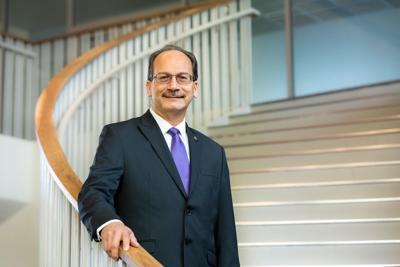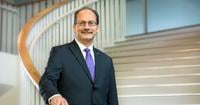The University at Albany’s new Institute for Social and Health Equity emerged from a request by the governor's office during the height of the pandemic.
Former Gov. Andrew Cuomo charged researchers with studying COVID-19’s disproportionate impact on people of color, University at Albany President Havidán Rodríguez said during an event launching the institute held Feb. 14 at the Harriman State Office Complex.
The request set off a collaborative effort involving dozens of researchers – from epidemiologists and public-health experts to criminologists and sociologists, building upon the already existing Center for the Elimination of Minority Health Disparities. The success of this effort eventually inspired the university to allocate $1.7 million to create the new Institute for Social and Health Equity.
“Our work exposed the significant gaps in knowledge and data about the health disparities experienced by minority communities, and the project sparked UAlbany’s health-equity research ecosystem, which has grown into what we call today the Institute for Social and Health Equity,” Rodríguez said.
That model, with a university research center following a request by a governor, isn’t necessarily the typical model. Often, researchers conduct their work independent of those on the policy side, more or less hoping that once a study is complete, its findings will be somehow useful to people who craft laws.
But this institute, from its most nascent stages, has been built upon a cross-pollination of research and policy. That’s why, as the work continues – scholarship that will look into everything from maternal and child health disparities, to the increased risk that people in low-income neighborhoods have of exposure to toxins – the institute’s leaders have an opportunity to develop studies that make a difference in the real world.
Through this institute, leaders have the chance to dispel the notion that academics are detached from reality, and instead be true partners with the public in tackling hugely consequential issues of disparity that inherently affect people’s lives.
Fittingly, institute leaders asked Adam Gamoran, president of the William T. Grant Foundation, to deliver a keynote address focused on the intersection of research and policy. Gamoran’s takeaway during the launch of the institute was that long-term two-way partnerships between researchers and policymakers can lead to research that shapes legislation – and therefore influences real people in a truly meaningful way.
“Researchers have this idea that our job is to figure stuff out, write it up, throw it over the wall, and there's somebody waiting on the other side of the wall to catch it. That is false. It does not work that way,” Gamoran said. “It turns out that getting evidence used is more about the relationships between producers and consumers of research.”
Gamoran said the “hard” sciences seem to embrace this connection.
The social sciences, not so much.
“Despite the power of partnerships, most social science units of universities are not designed to support them. In medicine, and engineering, faculty are rewarded for tech transfer. But in the social sciences, policy relevance is often met with disdain,” he said. “It's time for that to change.”
Paul Morgan, the Institute for Social and Health Equity’s inaugural director, told me he’s committed to leading researchers who work closely with policymakers – something UAlbany already does more than average universities because of its connections with state government.
“We are planning to deliberately and systematically reach out to policymakers to share what we're learning in the course of our research. This could include topics such as addressing disparities in breastfeeding or parenting practices or how to support older adults cognitively,” Morgan told me after the launch. “The typical model in academia is we do our research, and then we publish it in really jargon-filled, technical papers that are often behind paywalls. Central to our mission at ISHE is translating research findings in a way that is accessible to policymakers and the general public.”
If all of this sounds a bit jargony in its own right, consider the goal:
“It’s about translating research into tangible action. That’s what we’re looking for,” New York State Department of Health Commissioner Dr. James McDonald told me following the launch. “One of the things about health disparities is they are almost always preventable and they are almost all avoidable. But if we don’t have data on them, we don’t know what we’re preventing or avoiding, and that’s what we’re looking to do: translate research into meaningful public-health policy.”
This can be relevant to local leaders, too. For instance, if the Schenectady City Council wants to address issues of systemic racism, which the council has discussed more or less in the abstract over the past several years, its members could collaborate with UAlbany researchers to develop targeted laws. A similar model could work for a school board hoping to address disparities in academic performance within its district or a town government that wants to examine barriers to healthcare in a rural community.
“They can certainly approach us. We're here to help,” Morgan, the institute’s director, told me. “There are researchers across the university that are eager to work with community partners. And, then, sometimes, it’s a kind of matching process to find the expertise of the research team that’s right for the needs of the community. So we are eager to connect with local, state, national and global partners.”
The launch of this institute comes at a time when many in the public are disillusioned with academia, believing that theoretical pablum or high-minded essays on, say, institutional racism have little consequence on daily lives. But by partnering with policymakers at the local and state levels, researchers can prove they are here to help provide tangible solutions grounded in evidence.
“It will behoove us as researchers to be transparent about how we know what we know, what are the limitations of that knowledge and to be careful about presenting ourselves in terms of our scientific expertise,” Morgan told me. “I think that coming to policymakers with here's what we know in terms of the evidence base, here are our recommendations, here are limitations in that evidence base, and to be transparent about that, I think will be helpful.”
The pandemic exposed myriad social and health disparities in sharp and vivid detail, unfurling a range of reactions that have only widened partisan and other societal divides. With this new institute, the University at Albany has a formal commitment to address these disparities, not simply by pumping out volumes of academic scholarship and issuing clarion calls from an ivory tower, but by collaborating directly with members of the public.
“Working in a partnership means changing how we work,” Gamoran said. “It means making sure that decision-makers’ voices are included in the agenda for research.
“Why are we doing it?” Gamoran asked.
“Because we're trying to produce research that actually gets used.”









